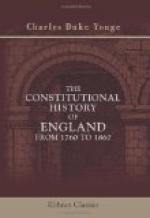[Footnote 295: Bishop Lonsdale, of Lichfield, in reference to Simon Magus, from whose offer of money to the Apostles the offence derives its name, denying that there was any similarity between his sin and the act of purchasing an advowson or presentation, remarked that it might just as fitly be called magic as simony.]
[Footnote 296: It has been, and will probably continue to be, a matter of dispute whether the first conception and plan of the insurrection originated with the restless boldness of the Mohammedans or the deeper fanaticism of the Hindoos. It is notorious that the prophecy that a century had been assigned by the Almighty as the allotted period of our supremacy in India had for many years been circulated among both; and, though the conspiracy was at first generally attributed to the Mohammedans, the argument that the period from the battle of Plassy, in 1757, to the outbreak in 1857, though an exact century according to the Hindoo calendar, is three years longer according to the Mohammedan computation, seems an almost irresistible proof that the Brahmins were its original authors. Sir John Kaye, in his “History of the Sepoy War,” at the end of book iii., c. iii., prints the following note, as furnished to him by Mr. E.A. Reade, a gentleman of long experience in India: “I do not think I ever met one man in a hundred that did not give the Mohammedans credit for this prediction. I fully believe that the notion of change after a century of tenure was general, and I can testify, with others, to have heard of the prediction at least a quarter of a century previously. But, call it a prediction or a superstition, the credit of it must, I think, be given to the Hindoos. If we take the Hejira calendar, 1757 A.D. corresponds with 1171 Hejira; 1857 A.D. with 1274 Hejira; whereas, by the lunisolar year of the Sumbut, 1757 is 1814 Sumhut, and 1857 is 1914 Sumbut.”]
[Footnote 297: It is worthy of remark that, as early as 1829, the Earl of Ellenborough, then President of the Board of Control, had come to the conclusion that the Company was no longer competent to govern so vast a dominion as that of British India had gradually become. In his Diary, recently published (ii., 131), he expresses his firm conviction that, “in substituting the King’s government for that of the Company, we shall be conferring a great benefit on India, and effecting the measure which is most likely to retain for England the possession of India;” and from the same work (ii., 61) we learn that Mr. Mountstuart Elphinstone, one of the ablest servants of whom the Company could boast, and who had recently been Governor of Bombay, even while confessing himself prejudiced in favor “of the existing system, under which he had been educated and lived,” admitted that “the administration of the government in the King’s name would be agreeable to the civil and military services, and to people in England. He doubted whether, as regarded the princes of India, it would signify much, as they now pretty well understood us.” See also ibid., p. 414.]




